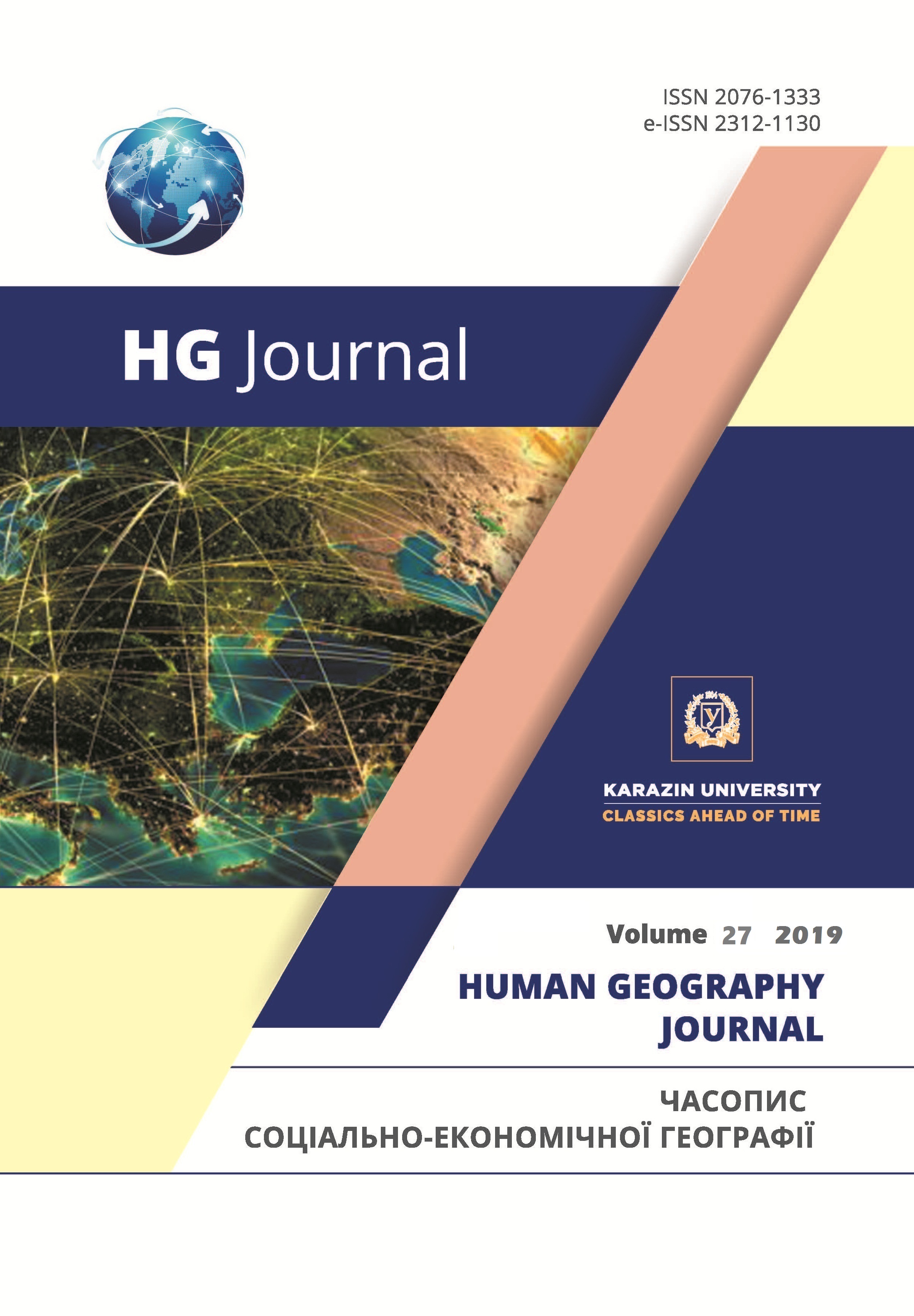To the methodology of socio-geographical research of the internal displacement of the population
Abstract
In this article, the author analyzes the approaches and methods of studying migration processes, in particular, forced internal displacement of the population. The analysis of foreign and domestic literature showed that domestic researchers of migration processes use traditional methods and approaches, while foreign scientists use interdisciplinary tools of approaches and methods. For a comprehensive socio-geographical study, it is necessary to combine traditional industry and interdisciplinary methods, which will reveal the real extent of forced internal displacement of the population at the regional and national levels. In addition, the use of this technique will allow conducting qualitative or quantitative studies of migrations, assessing the scale of migration processes, and revealing the structural and dynamic characteristics of migrants.
To study the internal population displacement, the author suggests using the following approaches: geographical, systemic, synergetic, informational, historical, demographic, economic, legal, sociological, psychological, individual. The author considers the use of traditional methods of socio-geographical research of migration processes. Of great importance are philosophical and general scientific methods, in particular analysis and synthesis, induction and deduction, observation, abstraction, and others. The necessity of using sociological and mathematical-statistical methods is substantiated. In this case, depending on the type of data collected, use qualitative (coding or content analysis) or quantitative (statistical methods: regression, descriptive statistics or modeling of structural equations) methods. The effectiveness of research on migration processes is enhanced by mathematical methods, in particular modeling. The following types of models are used in forecasting migration processes: open or closed models; discrete or continuous models; deterministic or stochastic models. The most effective, in our opinion, is the G. Zipf gravity model, as well as various types of regression models.
Downloads
References
Bartolomyu, D.D. (1985). Stohasticheskie modeli socialnyh processov [Stochastic models of social processes]. Moskva: Finansy i statistika, 295 [in Russian].
Zapadniuk, S.O. (2011). Mihratsii naselennya Ukrainy: peredumovy, dynamika ta naslidky rozvytku [Migrations of the population of Ukraine: background, dynamics and consequences of development]. Kyiv: Akademperiodyka, 240 [in Ukrainian].
Izard, U. (1968). Metody regionalnogo analiza: vvedenie v nauku o regionakh [Regional Analysis Methods: An Introduction to Regional Science]. Moskva: Progress, 659 [in Russian].
Pozniak, O.V. (2007). Mihratsiyni protsesy v Ukraini: suchasnyi stan i perspektyvy [Migration processes in Ukraine: current status and prospects]. Uman, 276 [in Ukrainian].
Naselennya Ukrainy. Trudova emihratsiya v Ukraini (2010) [The population of Ukraine. Labor emigration in Ukraine]. Kyiv: In-t demografii ta sotsialnykh doslidzhen im. M.V. Ptukhy NAN Ukrainy, 233 [in Ukrainian].
Niemets, K.A., & Niemets, L.M. (2014). Teoriya i metodologiya geografichnoi nauky: metody prostorovoho analizu [Theory and Methodology of Geography: Spatial Analysis Methods]. Kharkiv: KhNU imeni V.N. Karazina, 172 [in Ukrainian].
Niemets, K.A. (2009). Modelyuvannya trayektorii rozvytku regionalnykh sotsiogeosystem Ukrainy [Modeling the development path of regional socio-geosystems of Ukraine]. Chasopys sotsialno-ekonomichnoi geografii – Human Geography Journal, 7(2), 66-80 [in Ukrainian].
Perevedentsev, V.I. (1975). Metody izucheniya migratsii naseleniya [Methods of studying population migration]. Moskva: Nauka, 31 [in Russian].
Pistun, M.D. (1996). Osnovy suspilnoi geografii [Fundamentals of Human Geography]. Kyiv: Vyshcha shkola, 231 [in Ukrainian].
Pribytkova, I.M. (2009). Prostranstvennaya samoorganizatsiya naseleniya: teoretiko-metodologicheskie predposylki issledovaniya [Spatial self-organization of the population: theoretical and methodological background of the study]. Sotsiologiya: teoriya, metody, marketing – Sociology: theory, methods, marketing, 4, 84-98 [in Russian].
Rybakovskyi, L.L. (2001). Stadii migratsiynoho protsesu [Stages of the migration process]. Migratsiya naselennia – Population migration, 5, 125 [in Russian].
Topchiyev, O.H. (2005). Suspilno-geografichni doslidzhennya: metodologiya, metody, metodyky [Human geography researches: methodology, methods, techniques]. Odesa: Astroprynt, 631 [in Ukrainian].
Shabliy, O.I. (2001). Suspilna geografiya: teoriya, istoriya, ukrainoznavchi studii [Human geography: theory, history, ukrainian knowledge]. Lviv: LNU im. I. Franka, 744 [in Ukrainian].
Homra, A.U. (1979). Migratsiya naseleniya: Voprosy teorii, metodiki issledovaniya [Migration: Issues of Theory, Research Techniques]. Kyiv, 148 [in Russian].
Alba, R., & Nee, V. (1997). Rethinking Assimilation Theory for a New Era of Immigration. International Migration Review, 31(4), 826-874.
Benmayor, R., & Skotnes, A. (1994). On Migration and Identity. Oxford: Oxford University Press, 1-18.
Castles, S. (2000). International Migration at the Beginining of the Twenty‐First Century: Global Trends and Issues. International Social Science Journal, 52(165), 270-271.
Castles, S. (2007). Twenty-first century migration as a challenge to sociology. Journal of Ethnic and Migration Studies, 33(3), 351-71.
Niemets, L., Lohvynova, M., & Suptelo, O. (2019). Sociological methods in human-geographic researches: features of application. Chasopys sotsialno-ekonomichnoi geografii – Human Geography Journal, 26, 13-23. DOI: https://doi.org/10.26565/2076-1333-2019-26-02.
Niemets, L., Husieva, N., Pohrebskyi, T., Bartosh, O., & Lohvynova, M. (2020). Integration of internally displaced persons of Ukraine: realities, problems, perspectives. Visnyk Kharkivskoho natsionalnoho universytetu imeni V.N. Karazina, Ceriya “Geologiya. Geografiya. Ekologiyaˮ – Visnyk of V.N. Karazin Kharkiv National University, series “Geology. Geography. Ecologyˮ, (51), 140-157. DOI: https://doi.org/10.26565/2410-7360-2019-51-10.
Pribytkova, I.M. (2007). Cartographical Modeling as a Statistical Method for Monitoring of a Spatial Behaviour of Population. Recent Advances in Stochastic Modeling and Data Analysis. World Scientific Publishing Co. Pte. Ltd.
Reilly, W.J. (1953). The law of retail gravitation. New York: Pilsbury Publishers, 75.
Smith, A., Campbell, R.H., & Skinner, A.S. (1976). An inquiry into the nature and causes of the wealth of nations. Oxford: Clarendon Press, 535.
Stouffer, S.A. (1940). Intervening Opportunities: A Theory Relating Mobility and Distance. The American Sociological Review, 6, 845-867. Retrieved from http://www.jstor.org/ stable/2084520 23.
Zipf, G.K. (1950). Human Behavior and the Principle of Least Effort. The Economic Journal. Retrieved from http://www.jstor.org/stable/2226729.
Copyright (c) 2019 Lohvynova M.

This work is licensed under a Creative Commons Attribution 4.0 International License.




